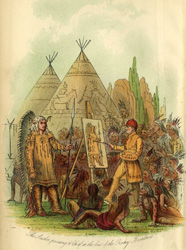

George Catlin, The Author Painting a Chief in an Indian Village, frontispiece in Catlin, Letters and Notes.... vol. 1 (London, 1841)
In 1841, George Catlin (1796-1872) published his Letters and Notes on the Manners, Customs, and Condition of the North American Indians, in two volumes with about 300 engravings. Based on five trips to the west, the text and images were an attempt "to rescue from oblivion their primitive looks and customs." At the same time the text and illustrations are not neutral records but are products of Eurocentric attitudes and perspectives. George Catlin is primarily noted for his "re-presentations"
of native Americans. In this frontispiece he uses the Eurocentric
ideology of re-presentation to assert the authority of his images
and account. The assumption that Catlin's image depends upon,
is that Western modes of re-presentation
are more "real' than those of other cultures, in this case
Native American. He makes this point by comparing his "mastery"
of Western conventions of perspective and knowledge of anatomy
to the "primitivism" of the art of the Native Americans
manifested by the figures decorating the tipi in the background which echo the traditional Mandan forms of representation as found on a buffalo robe.
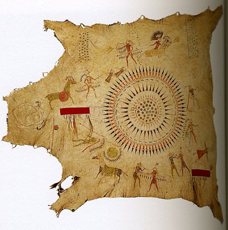 It is not by chance that he presents himself painting an oil painting.
Compare this to the social, cultural, and economic implications
of oil painting articulated in John Berger's account of the media.
It is not by chance that he presents himself painting an oil painting.
Compare this to the social, cultural, and economic implications
of oil painting articulated in John Berger's account of the media.
The astonishment of the Native Americans in beholding Catlin's
painting is reminiscent of the nineteenth century British critic
John Ruskin's account of the "inability" non-western
obervers to read western images. Rather than using this phenomenon
to question the universality of Western modes of picture making,
Ruskin uses this as evidence that "the truth of nature is
not to discerned by the uneducated senses":
The Chinese, children in all things, suppose a good perspective drawing to be as false as we feel their plate patterns to be, or wonder at the strange buildings which come to a point at the end. And all the early works, whether of nations or of men, show, by their want of shade, how little the eye, without knowledge, is to be depended upon to discover truth. The eye of a Red Indian, keen enough to find the trace of his enemy or his prey, even in the unnatural turn of a trodden leaf, is yet so blunt to the impressions of shade, that Mr. Catlin mentions his once having been in great danger from having painted a portrait with the face in half light, which the untutored observers imagined and affirmed to be the painting of half a face.
Note how Ruskin assumes in his use of words like "knowledge" and "truth" that Western education, culture, art, etc. is more directly tied to "objective truth" or to the "real."
In Catlin's illustration it is significant to note that he has included tipis in the background. Tipis were characteristic of the Plains tribes, while the Mandan villages consisted of hemispherical, earthen lodges. 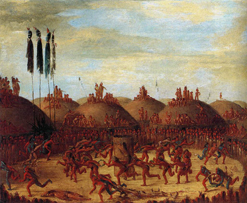 Catlin would have been aware of this distinction in the customs of the different groups. His conflation of this image of the sedentary, agrarian Mandan people with the tipis of the migratory Plains tribes helps to create the generic concept of the American Indian for which the tipi will become a characteristic symbol. The American Indian is an identity constructed within Eurocentric culture and not within the indigenous groups themselves.
Catlin would have been aware of this distinction in the customs of the different groups. His conflation of this image of the sedentary, agrarian Mandan people with the tipis of the migratory Plains tribes helps to create the generic concept of the American Indian for which the tipi will become a characteristic symbol. The American Indian is an identity constructed within Eurocentric culture and not within the indigenous groups themselves.
Catlin presents the following account of his encounter with Mah-To-Toh-Pa in his Letters and Notes:
| Mah-to-toh-pa had agreed to stand before me for his portrait at an early hour of the next morning, and on that day I sat with my palette of colours prepared, and waited till twelve o'clock, before he could leave his toilette with feelings of satisfaction as to the propriety of his looks and the arrangement of his equipments; and at that time it was announced, that "Mah-to-toh-pa was coming in full dress!" I looked out of the door of the wigwam, and saw him approaching with a firm and elastic step, accompanied by a great crowd of women and children, who were gazing on him with admiration, and escorting him to my room. No tragedian ever trod the stage, nor gladiator ever entered the Roman Forum, with more grace and manly dignity than did Mah-to-toh-pa enter the wigwam, where I was in readiness to receive him. He took his attitude before me, and with the sternness of a Brutus and the stillness of a statue, he stood until the darkness of night broke upon the soiltary stillness. His dress, which was a very splendid one, was complete in all its parts, and consisted of a shirt or tonic, leggings, moccasins, head-dress, necklace, shield, bow and quiver, lance, tobacco-sack, and pipe; robe, belt, and knife; medicine-bag, tomahawk, and war-club, or po-Ko-mo-Kon. |
Catlin lends nobility to the Mandan chief by understanding him in the context of Classical figures. The standing pose of the chief echoes the Classical contrapposto pose:
Similarly the amazed figures sprawling on the ground in the foreground of the illustration recall Classical figures like the Dying Gaul from Pergamon:
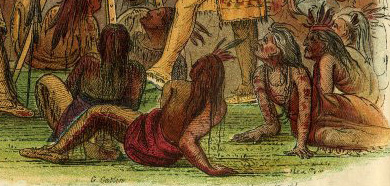 |
|
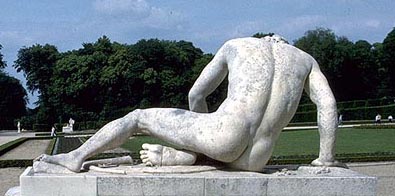 |
The Greek Hellenistic artist's noble image of a dying barbarian was a fitting prototype for Catlin's image of the Noble Savage of the American West.
Compare Catlin's representation to the codes articulated by Hal Foster in his discussion of the ideology of Primitivism.